Bettina Cruz takes the microphone. She raises her voice in her indigenous language Diidxazá (Zapotec) to speak against the interoceanic corridor projected in the Isthmus of Tehuantepec, one of the megaprojects prioritized by the Andrés Manuel López Obrador presidential administration. Behind her, the Calenda advances through the town of Juchitán. Dressed in a flower-embroidered huipil traditional to Oaxaca and a long colorful skirt, Bettina reminds all present that megaprojects destroy her community’s land, which she promises to continue defending. Night has already fallen.
The next day, communities and organizations from the countryside and the city will hold seven work tables, each one agreeing it necessary to establish a national front against the megaprojects promoted by López Obrador’s so-called “fourth transformation” of the country. They agree to a national campaign of protests held on strategic dates. They contemplate direct action through art and the mass dissemination of information to visibilize the territories at risk. They emphasize the importance of informing communities via word-of-mouth about the risks of an interoceanic industrial corridor that seeks to cross commodities in 10 hours between the Pacific Ocean and the Atlantic.
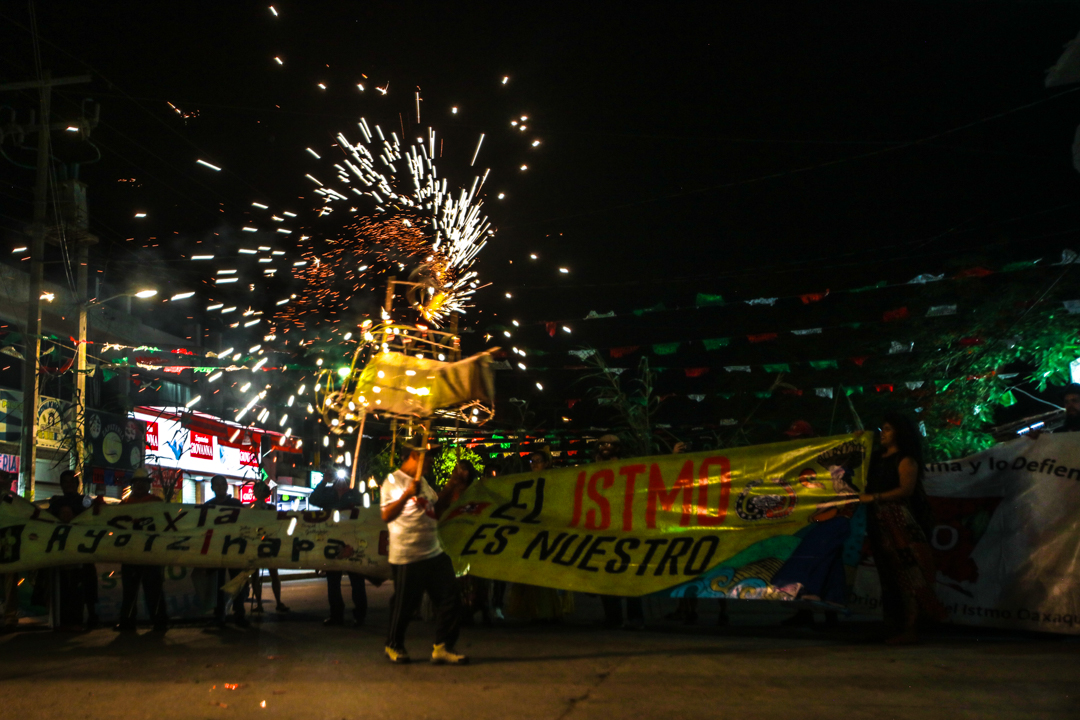
The Calenda
The crowd advances with candles and reeds of carrizo in hand and with banners that say “The Isthmus Is Ours.” The sounds of two drums and a flute encourage their step. Fireworks tremble among houses that remain demolished by the earthquake of 2017. Residents come out to their doorsteps to see what’s happening. It is the Calenda inaugurating the National Assembly of the National Indigenous Congress (CNI) together with allied networks and organizations.
“The Calenda announces something very important and calls on people to participate. It’s a ritual of the peoples in Oaxaca, which is how they find out about the activity and participate. It’s popular,” explains Bettina.
A Binizáa woman recognized for raising her voice against wind energy projects in the Isthmus, Bettina Cruz is a member of the Indigenous Governing Council (CIG). Her participation in the National Indigenous Congress (CNI) is very active, and she is a founder of the Assembly of Indigenous Peoples of the Isthmus of Tehuantepec in Defense of Land and Territory (APIITDTT). Because of her activity in defense of life in the Isthmus, she has been threatened, monitored, and even detained for “undermining national wealth.” In this assembly, she welcomes more than 500 participants from 20 states and 17 indigenous peoples.
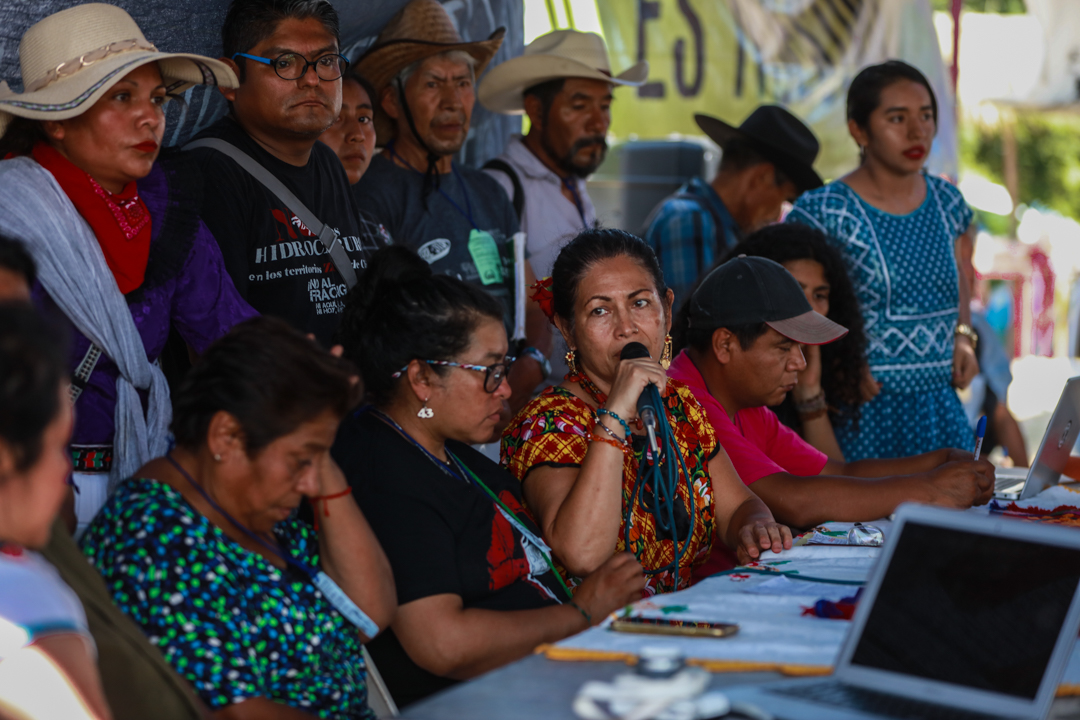
Train, gas pipelines, highways: the trans-isthmic corridor
“They want to achieve it with a four-rail high-speed train system. Not like the one that exists now. [And] the construction of a highway that runs parallel to it as well as a gas pipeline—an industrial corridor requires gas, fossil fuels, and electricity. That is why this is an area where wind farms already produce three-thousand megawatts of energy per hour. And the project seeks to build 20 more wind farms. The other part is a city corridor where the megaproject’s workers can live. And who are they? The other part is to stop migrants with this as a wall through pauperized jobs. All this will need services, energy, water.” This is how Bettina denounces the project. She also points out that the Isthmus is not an industrial zone but a region dedicated to agriculture, fishing, livestock, goldsmithing. And she emphasizes: whether with the refinery or with the wind farms, poverty has already increased in the region.
“This is only for the benefit of multinational corporations, it is not for us indigenous peoples.” Throughout the Isthmus, both in Veracruz and Oaxaca, there are 13 peoples: Zapoteco, Mixe, Náhua, Zoque Popoluca, Mixe Popoluca, Zoque Chimalapa, Chinanteco, Mixteco, Chontal, Ikoot, Chochoco, Tsotsil, and Afro-descendant.
The invisible value of the jungle
The Isthmus is part of the Mesoamerican biological corridor and where the Chimalapas are found: 600 hectares bringing together a set of ecosystems unique in the world and where 40% of the country’s biodiversity is found: coniferous and oak forest, spiny forest, mesophyll, deciduous lowland forest, evergreen highland forest, medium subcaducifolia jungle. This is where Mexico’s highest concentration of orchids is, as well as its largest amount of water because of the high quantity of rivers, streams, and springs. Specialists agree that the megaproject would mean ecological depredation.
In total, the trans-isthmic interoceanic project will affect 80 municipalities: 31 in Veracruz and 49 in Oaxaca.
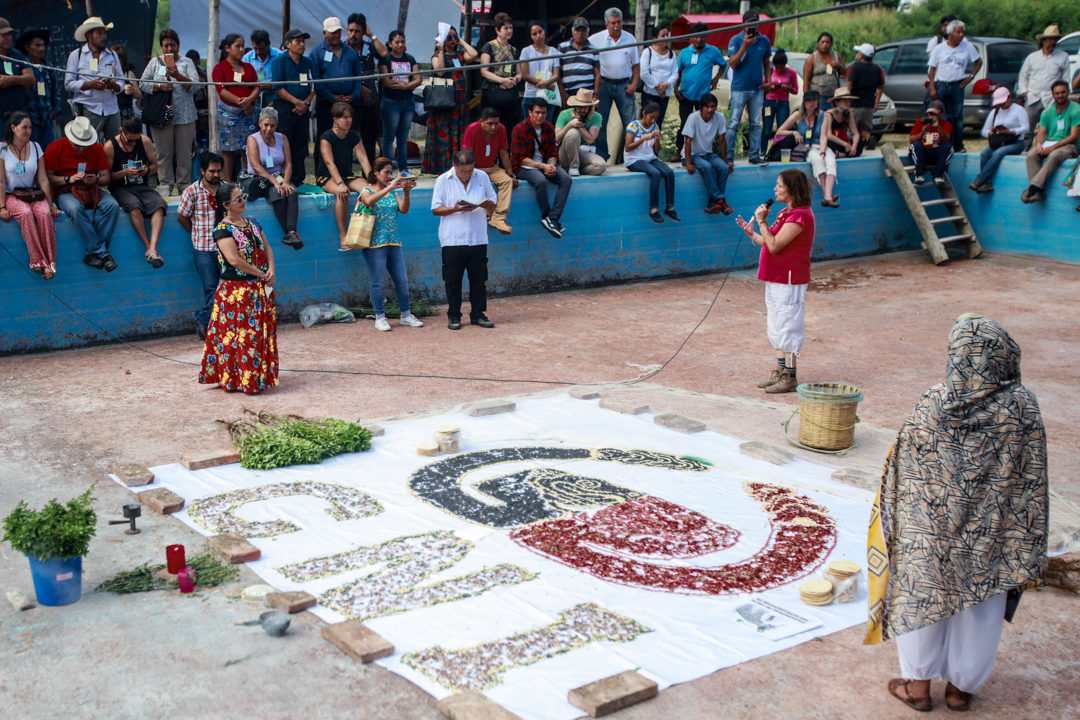
Megaprojects that attract crime and violence
The call of this Calenda was neither to a saint’s party nor to a dance; it was a call to discuss the megaprojects and the situation that indigenous communities live in Mexico. It was, above all, to amplify the voice of the peoples through which the trans-isthmic corridor seeks to cross.
“The corporations have joined up with the cartels,” denounces Bettina at the table that kicks off the National Assembly. The Nahua and Popoluca peoples next denounce mining and fracking; the Mixe people of Matías Romero assure that consultations pretending to be assemblies have been made with communities unaffected by the project and with participants tied to the government; the Zoque people of the Chimalapas ensure that the project plans to take the water for mining purposes and to feed the industrial cities it seeks to build; the Ikoot communities of San Mateo del Mar denounce that the birds are no longer arriving because of the wind farms and that the government has dedicated itself to dividing the communities so that they accept these projects; the Zapotec people declare that the trans-isthmic project will not move forward.
This is the second national assembly convened by the CNI that includes deindigenized or mestizo people, the majority from urban areas where they organized as a network to collect signatures to get CIG spokeswoman María de Jesús Patricio Martínez (“Marichuy”) on the presidential ballot in 2018. The first such assembly took place in Amilcingo, Morelos on April 9, 2019. This assembly in the Isthmus gives continuity to those joint coordination agreements.
Fourth Transformation: negative diagnosis
Of the current government, the indigenous communities have the following diagnosis: there is now more militarization in their communities, violence and harassment have increased, the social programs are conditioned to accept megaprojects.
For example, they accuse the government program Sembrando Vida (Sowing Life) of strengthening the cacicazgo model where an indigenous elite helps maintain colonial rule. They describe López Obrador’s National Institute of Indigenous Peoples (INPI) as one dedicated to folklorizing rituals and banalizing indigenous referents. They insist there’s now a more marked counterinsurgency strategy coming from the State where the enemy is now “more diffused.” For this reason, they propose a “de-batonization” of Andrés Manuel López Obrador for violating the rights of the original peoples.
For Marichuy, spokeswoman for the CIG, there is now a double risk because the president is “two-faced.” As she puts it in an interview, “Above he says one thing, and below he is doing another that is very hard for the peoples. The megaprojects are the ones that are destroying our villages right now. All the violence has been exacerbated since this government arrived.”
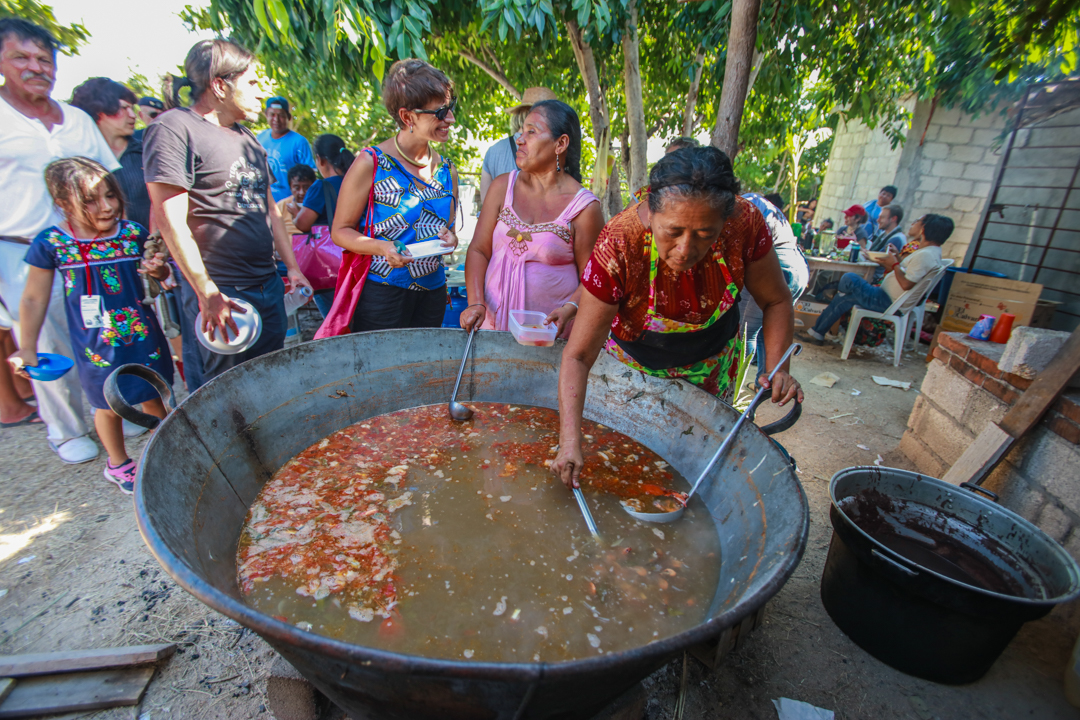
The trans-isthmic: an old acquaintance
During the Porfirio Díaz government in the early twentieth century, the trans-isthmic train was built. The project was taken up again by the treaty that Benito Juárez signed with the United States (McLane-Ocampo), according to the Miguel Ángel García Aguirre, current director of the non-governmental organization Maderas del Pueblo. The project was originally designed for trade between oceans, but it did not last long. The train only worked from 1907 to 1914, the year the Panama Canal was inaugurated, which would monopolize international commercial transport through the Isthmus.
In 1967, then-president Gustavo Díaz Ordaz attempted to boost cargo transport between the oceans. During his six-year term, the Pajaritos petrochemical plant was built in Coatzacoalcos. Later in 1974, the Luis Echeverría administration projected the application of the trans-isthmic railway. And three years later, by 1977, the José López Portillo administration would launch the Alfa-Omega plan as a trans-isthmic cargo transport system that used containers. During Portillo’s six-year term, the Cangrejera petrochemical plant and the Salina Cruz Refinery opened. And in 1985, Miguel de la Madrid began on the construction of the Nueva Teapa Salina Cruz pipeline.
One project that resembles the one promoted by the current government is one that Ernesto Zedillo unveiled in 1996. “They are very similar,” says Miguel Ángel García, showing the maps he has made since then. The former president announced the Comprehensive Economic Development Program for the Isthmus of Tehuantepec, which not only contemplated interoceanic transport but also goods and services for the area along with industrial development.
War and commerce
In 1997, the Zapatista Army of National Liberation (EZLN) published “Seven Loose Pieces of the Global Jigsaw Puzzle,” a communiqué that analyzed in piece number seven the proposal of then-president Ernesto Zedillo through his Program of Integrated Development for the Isthmus of Tehuantepec: “The foreseeable results of all these projects will be, among others, the fragmentation of Mexico (separating the southeast from the rest of the country). In addition, and since we are talking about war, the projects involve counterinsurgency.”
Vicente Fox later promoted the project through the Plan Puebla-Panama (PPP), and Felipe Calderón then announced in 2007 the Sistema Logístico del Istmo (Logistical System of the Isthmus) to solicit bids on container terminals in both ports and the operation of a modern freight railway accompanied by a multimodal corridor. Similarly, Enrique Peña Nieto announced in 2013 the Plan Istmo Puerta de América (Plan Isthmus: Door of America) and sought to move it forward again through the Exclusive Economic Zones announced in 2016.
During each of these moments, each of these projects came up against the defense of life by the 12 indigenous peoples of the Isthmus region, both in the Veracruz area and in the State of Oaxaca. They are the same peoples that now stand against the attempts of President Andrés Manuel López Obrador who, in 2004 published the book Un proyecto alternativo de Nación (An Alternative Nation Project), where he outlines a comprehensive program for the development of the Isthmus.
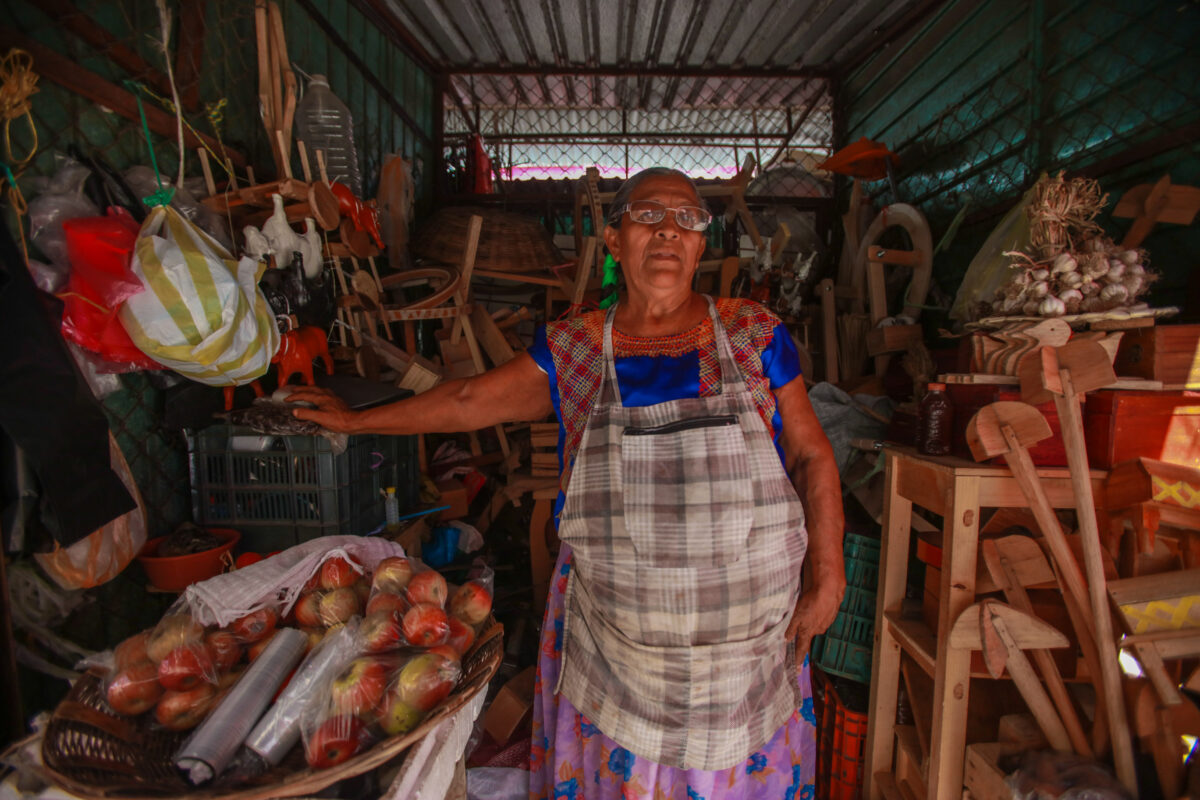
Bettina Cruz smiles as she moves away from the work tables to tend to the interview, emphasizing “the Isthmus is ours, but ours as we say in Diidxazá: ours of the community on the one hand, but also ours of the whole world on the other.”
López Obrador’s claims
In section III of the National Development Plan (PND) entitled “Economy,” the government mentions the trans-isthmic corridor project in two chapters. The first is entitled “Respect for existing contracts and encourage private investment,” which ensures that this corridor, together with the Maya Train and the Northern Border Free Zone, will generate “jobs and decent living conditions to attract and anchor those fleeing poverty.” And it literally warns that the “regional development projects act as ‘curtains’ to capture the migratory flow in their transit to the north.”
The PND dedicates a section to describe the “Program for the Development of the Isthmus of Tehuantepec.” It says that the objective is to boost the growth of the regional economy with an Interoceanic Multimodal Corridor, which takes advantage of “the position of the Isthmus to compete in the world markets of commodity transport, through the combined use of various means of transport.”
In order to carry this corridor out, the government plans to modernize the Isthmus of Tehuantepec railway as well as the ports of Coatzacoalcos (Veracruz) and Salina Cruz (Oaxaca) so that they can offer freight, transport, storage, and packaging services, yet without specifying whether more roads would be built and without saying how the infrastructure of highways, rural roads, or the airport network will be strengthened. It will involve 76 municipalities in Oaxaca and Veracruz.
In addition, the PND is considering the construction of a gas pipeline to supply companies and domestic consumers: “Along the route between both oceans, free zones will be created to attract private sector investments, which will be provided with infrastructure and will be guaranteed the supply of energy, water, digital connectivity, and other basic inputs to meet the needs of companies and the working population.”
With a decree dated June 14, 2019, President López Obrador created a decentralized public body called the Interoceanic Corridor of the Isthmus of Tehuantepec. It considers it a priority to increase international trade, which requires a “logistics platform.”
This body must “procure, through public and private investment, the construction of the physical, social, and productive infrastructure necessary to strengthen the economic base of the region of the Isthmus of Tehuantepec.”
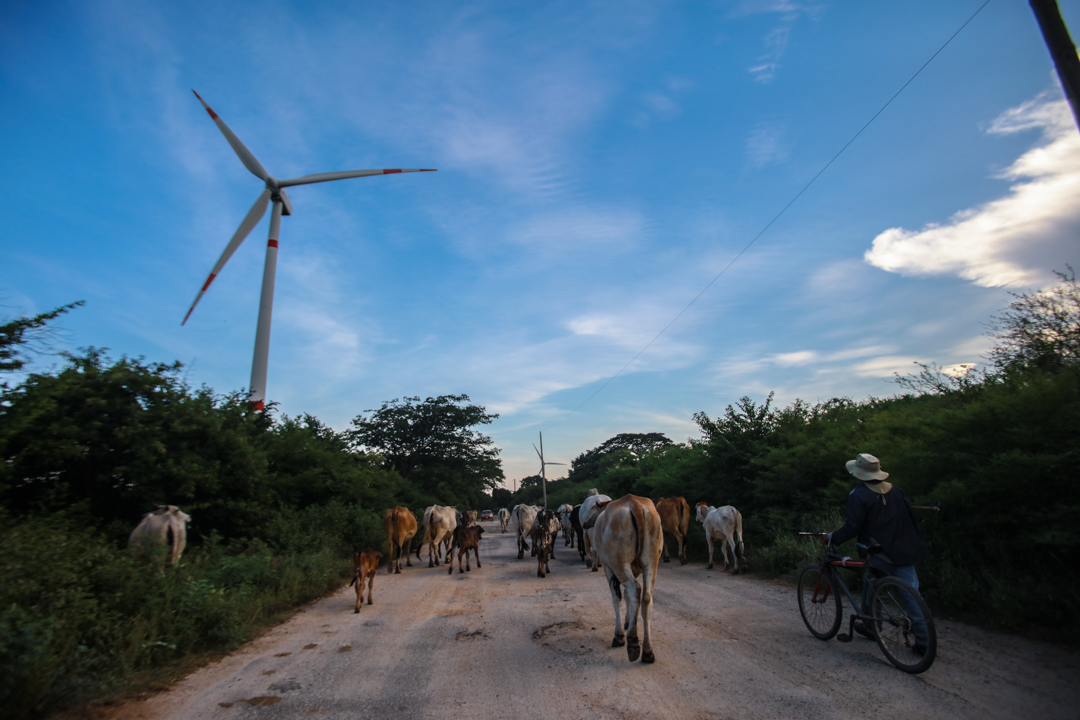
Low taxes: the hook
The PND details that this corridor will be a free zone, where VAT and ISR taxes will be decreased and fuel will be offered at reduced prices. It also ensures that on March 30 and 31, 2019 the government obtained the authorization of the peoples of the region in a consultation conducted with regional assemblies. According to the head of the decentralized agency, Rafael Marín Mollinedo, the investment allotted by this presidential administration to the project will be approximately 12.9 billion USD.
According to a document from the Government of Oaxaca signed by Secretary of Economy Jesús Rodríguez, the corridor project includes the creation of alliances between companies in industrial clusters for logistics and modalities of commercial and energy transport: agro-industrial, manufacturing, construction and housing, aquaculture, oil and energy, and mining, in addition to an intercity metrobus (Istmobús).
Even with this information, it is not clear what the entire project would entail. Bettina Cruz demands before the CNI assembly that as peoples, they have the right to receive the precise information of what the government intends to impose in the territory of the Isthmus in order to make a decision.
“We are not saying no to everything. We are saying that they do not inform us how our life is going to change, how development is going to impoverish us more, what kind of development, for whom, and with what. We want to know all of that,” she demands.
Battle in the symbolic
The Calenda lights a firework torito in the middle of the circle created by those who marched. Professor Jorge, delegate of Amilcingo is responsible for carrying the lit torito. As it hovers he begins to shout “¡Samir vive!” (Samir lives!) Those around him respond, “¡La lucha sigue!” (“The fight continues!”) In this way, he has asked for a “¡Viva!” for the original peoples in resistance, for the EZLN, and the CNI. It’s that encouragement that inaugurated the assembly, the spirit of remembering Samir: “Six months after his murder, impunity continues. They have not taken the case up at the federal level,” denounced the professor.
The EZLN named its new campaign to break the siege “Samir Flores Lives.” At the work tables, the participants were asked to greet the convocation emanating from Zapatismo in Chiapas to attend their calls to construct the new caracoles, Zapatista good-government coordination points.
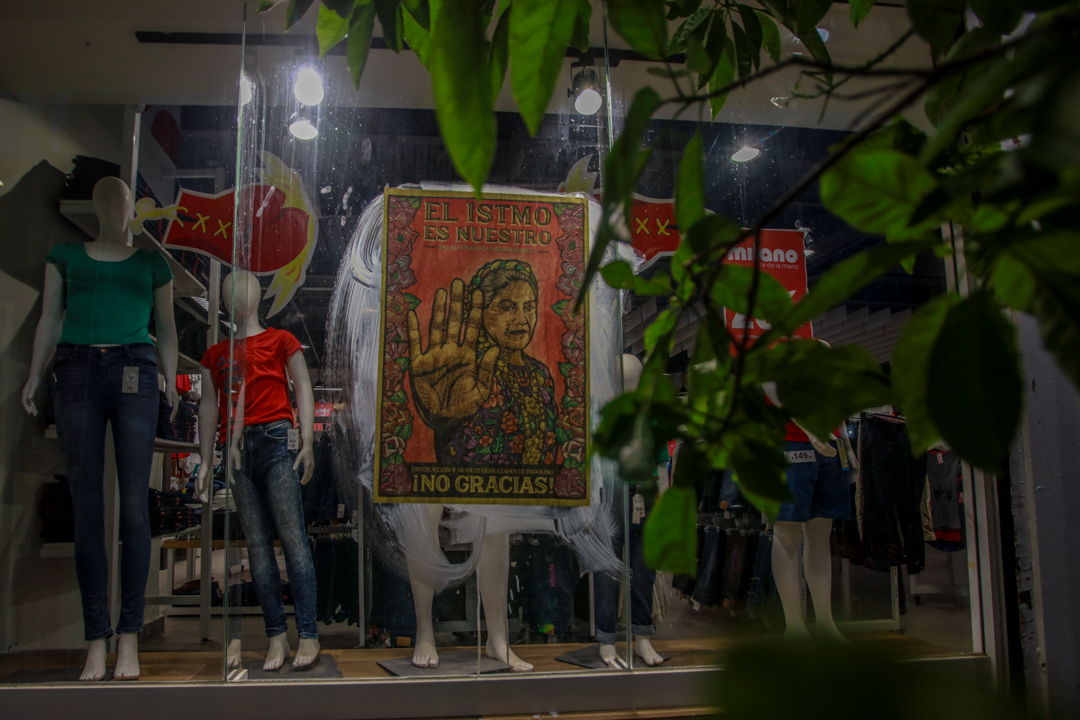
Adding the urban
Urban people, deindigenized, dialogued together for more than four hours with indigenous people from the countryside and the city. It is the second assembly held by the National Indigenous Congress with this mixture. But here there was a difference. In the first, the mestizo ethnic group monopolized the word. This time seemed to hold greater synergy in the exchange of ideas. Thus, the issues of violence against women and of encouraging the participation of all against patriarchy were more present than in other assemblies.
“There’s still a little discussion by those who do not feel fully included, but I felt it seems that it’s taking shape. It’s not yet clear that we cannot fill ourselves with actions that we are not going to be able to carry out, that we do not lose the main struggle that brings us together, but it’s walking along as a work space. I felt that there was more dialogue, more listening, more agreements, all without imposing voices, differentiating the urgent from the important.” Such is the diagnosis of the assembly that has as its spokeswoman María de Jesús Patricio Martínez, who observes a maturation process by combining efforts beyond the CNI.
For the Nahua delegate of Papantla, Oscar Espino, it is still necessary to listen, match rhythms, but above all, achieve an understanding of the rhythms of struggle because “those in the city go very fast. We the indigenous go step by step. They go by car, and we walk.”
For Verus, a member of a Cultural Collective in Nicolas Romero, State of Mexico, it is necessary for urban people to recognize the struggle of indigenous peoples and stop imposing terms of political struggles that do not match the ideal of resistance. For him, there is still a misunderstanding of what the CNI means and a process of decolonization of minds is needed.
But the assembly flows and at the time of the agreements, there is an emphasis on highlighting and recovering the indigenous symbols and referents that the government “has appropriated” to legitimize its megaprojects. Therefore, the proposal arises to create a national campaign against megaprojects and communicate from the traditional, the ritual, to claim those referents. Along with appropriating indigenous symbolism, López Obrador’s INPI even replicated the scheme of the Indigenous Governing Council as proposed by the CNI in order to get indigenous communities to relate to his administration’s Institute.
At the end of the assembly, the Ikoot community announces it has prepared a seafood broth for all participants. It is part of what this Calenda summoned. In the kitchen there is also a political space that places the products of the region in the center so that they are not lost. This community has denounced the wind farms near the sea as having reduced fishing, and now the sea life is not the same as before.
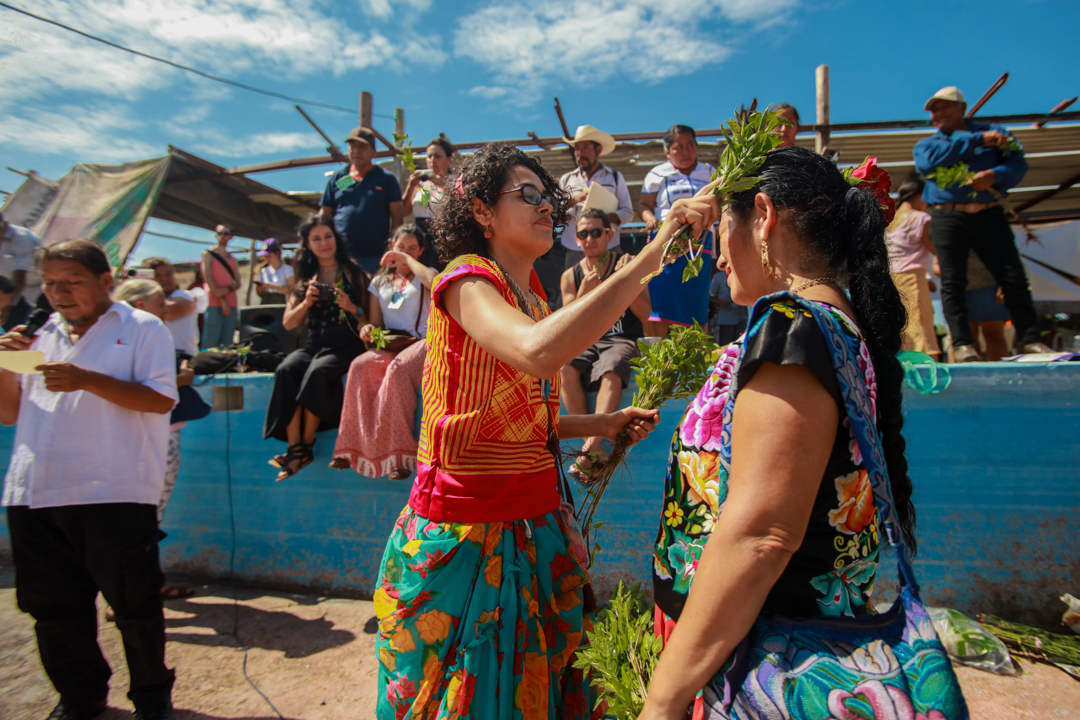
Key dates of resistance
Marina, a Binnizáa youth, distributes the candles before starting the Calenda. People receive them and as they walk behind the music they illuminate those who come back to walk the streets of downtown Juchitán. She says that the Calenda in this case is for the celebration of the word and ideas that is the assembly of the CNI, but above all to invite people to be aware of what is happening in Juchitán.
Megaprojects in the Isthmus have had clear consequences, according to Bettina. This includes the changes in the flow of water in the upper lagoon, which has impacted fishing, pollution, as well as water control for the 10 cities. As if not already scarce, people from outside arrive and traditions change, low wages, the increase of the National Guard to provide certainty to entrepreneurs that their investments will be carried out. “This is what we see with what there is now and without having accurate information about what’s coming.”
Bettina says that since the advent of wind companies, prostitution, organized crime, violence, water and land pollution, death, impoverishment, and marginalization have increased. “But here we are. We will not let our territory be taken away from us.”
Like the candles that illuminate the Calenda, the CNI seeks to illuminate the minds a little of those who listen to them. That they realize the devastation that the trans-isthmic interoceanic corridor project will mean to the social fabric of the communities and in the biodiverse territory.
The key date is October 12, the 23rd anniversary of the CNI. A day for disbursed actions nationwide against megaprojects. On the linear calendar: they set out to protest on September 20 against climate change, on September 26 for the 43 disappeared students of Ayotzinapa, then on the October 12 anniversary of the CNI, and on November 25 against violence against women. Within this action plan, they will attend the EZLN calls by agreement.
The CNI, once again, resurrects into the light.
Originally published in Pie de Página.
English translation by Semillas collective in New York and Semillero 805 collective in California.


